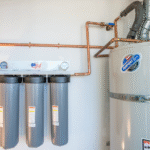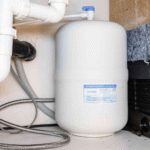If you’ve lived in southern Utah long enough, you’ve probably dealt with hard water. Maybe your showerhead is crusted with white buildup, or your dishes come out looking like they’ve been snowed on. Sound familiar? Welcome to St. George, where hard water is practically part of the landscape. But there’s good news—water softeners work wonders here. The real question isn’t whether you need one (spoiler: you do). It’s what you should feed it: salt or potassium?
Let’s talk about the water softener salt vs potassium debate—and why the decision is more than just picking a bag off the hardware store shelf.
First Off, Why Bother With a Water Softener?
Hard water isn’t dangerous, but it is annoying. It leaves mineral deposits in your pipes, on your faucets, and in your appliances. Over time, that buildup can reduce water pressure, make heating systems less efficient, and shorten the lifespan of everything from dishwashers to water heaters.
A water softener fixes that by swapping out the minerals—mainly calcium and magnesium—with either sodium or potassium ions. That’s where the choice kicks in.
The Old Standby: Salt (Sodium Chloride)
Salt’s been used in softeners for decades, and for good reason—it works. It’s affordable, efficient, and easy to find in big ol’ 40-pound bags at your local hardware store.
Benefits of salt:
- It’s very effective at removing hardness minerals.
- Systems using salt usually regenerate less often, which saves water.
- It’s cheaper—both upfront and long-term.
But, as with most things, there are trade-offs.
The main concern is sodium in your water. Now, to be clear, it’s a small amount. Most people won’t even taste it, let alone feel any effects. But if you’re on a low-sodium diet, or just don’t like the idea of added salt in your water, it might give you pause. Also, softeners using sodium release brine into the wastewater, which some environmentalists say isn’t great for soil or septic systems.
The Kinder, Greener Option: Potassium Chloride
Potassium does the same job—swapping out those hard minerals—but instead of sodium, it uses potassium ions. On the surface, that sounds better, right? Especially for your health and the environment.
Here’s the upside:
- No added sodium in your water.
- Friendlier to plants, soil, and septic systems (great if you’re reusing softened water outdoors).
- A healthier choice if you’re watching sodium intake.
But (you knew it was coming), it’s not perfect either.
Potassium chloride can cost two to four times more than salt. And it’s not quite as efficient, which means your softener may regenerate more often—using more water and electricity. If you’ve got a large household, the difference in cost can really add up.
And Then There’s St. George…
Here in water softener St George Utah territory, we deal with some of the hardest water in the region. It’s practically a rite of passage. Most homes—especially newer ones—already have softeners installed, and folks here know how crucial it is to maintain them.
Because of the climate and water conditions, the choice between salt and potassium is a common topic. Salt is by far the more popular option—mainly because it’s cheaper and effective. But if you’re eco-conscious, have sensitive skin, or are just trying to live a little cleaner, potassium is gaining ground.
Some locals split the difference—using salt most of the year and switching to potassium when irrigating gardens or landscaping. It’s a clever hack, especially in drought-prone areas where every drop counts.
So… What Should You Choose?
There’s no universal answer here, just personal priorities. If you’re budget-conscious and don’t have any health restrictions, salt is probably the way to go. It’s simple, efficient, and has stood the test of time.
But if you’re concerned about the environment, your garden, or your sodium intake, potassium might be worth the extra bucks.
Either way, maintaining your softener is key. Check your settings, clean out the brine tank now and then, and make sure you’re not overfilling it. It’s a small effort that pays off in better water, happier appliances, and a little more peace of mind.
Final Thoughts: It’s Not Just About Soft Water
People tend to forget that water affects everything—your clothes, your skin, your plumbing, your coffee. So while choosing between salt and potassium might not seem like a life-altering decision, it’s one that ripples throughout your daily routine.
Think about what matters most to you. Whether it’s saving money, protecting your landscape, or avoiding sodium, there’s a solution that fits. The important part is having a system in place that actually tackles St. George’s stubborn hard water.



